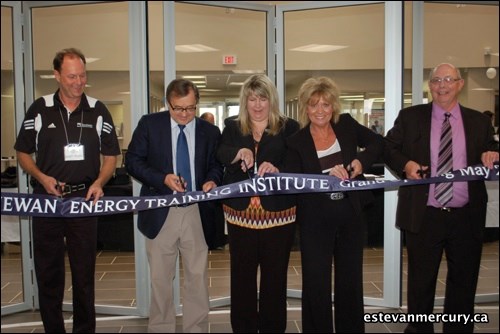The formal portion of the program was brief but impressive as over 200 people gathered in the main auditorium of the Saskatchewan Energy Training Institute (SETI) in Estevan for an official launching party.
A number of Saskatchewan MLAs joined Souris-Moose Mountain MP Ed Komarnicki to celebrate the official opening of the training centre built under the auspices of the Southeast Regional College.
Also on hand were several members of the college's board of directors who oversee the college's programs and SETI's training courses and projects.
Jody Holzmiller, interim president and chief executive officer for the SERC, served as emcee for the program that followed an open house and tours of the 44,000 square foot facility.
Holzmiller provided a brief history of what transpired prior to the construction of the SETI. She said the idea was first brought forward in 2005. The actual construction didn't begin until 2009 with a sod-turning ceremony and by the summer of 2010, it was well underway. In February of this year, SETI opened for its first classes.
Komarnicki said he remembered receiving a call from college personnel wanting to see if this type of project could be possible from a federal grant perspective. He noted that once the wheels were put in motion, the paperwork got done in rather rapid fashion, and in fact, he noted with a touch of whimsy, in the world of political red tape "it was done with lightning speed."
Komarnicki added that with the ongoing struggle for industry to meet skilled labour demands, building trades expertise in a facility such as this, especially in an industrial hot spot like Estevan, was vital.
"You have the flexibility to meet the needs of the economy without a lot of cost, that's what regional colleges do ... they meet that criteria."
Komarnicki pointed out how the SETI embraced the latest in technological training and while the federal government provided some upfront money, the operations will require support from local governments, students and industry itself as they "take the next level of training in the specific industries. You'll see the benefits right here and well beyond."
Estevan MLA Doreen Eagles introduced her provincial counterparts, MLA Greg Lawrence from Moose Jaw Wakamaw; Cannington MLA and Legislative Speaker Dan D'Autremont and Moosomin MLA Don Toth who were present for the ribbon cutting. She thanked the federal government for their support and noted it was a proud day for the provincial government that stood behind the project from Day 1 through the Ministry of Advanced Education. She also noted that the City of Estevan had donated the large parcel of land that accommodates the SETI in the east industrial subdivision.
"It's a great day for all of us," said Estevan Mayor Gary St. Onge. "You have a beautiful and efficient building here with the potential to be the most important educational institute in the region. It's nice to be on the side of the positive business explosions, and it will be interesting to see what direction the SETI board takes them because continual training is very important."
St. Onge added that the local political representatives worked hard to make SETI happen and he credited the local business lobby for ensuring that it happened here.
Board member Bernie Bjorndalen, a two-year representative, said SETI was a world-class facility.
He also thanked the politicians for their skill and willingness at forming partnerships to make it happen. "It was a huge job of lobbying and it was so nice to see all working together for the common goal of advanced education. Now SETI can grow in the future. On a daily basis we're now making dreams become reality."
Bjorndalen urged students to make SETI their first choice for additional training because it was "leading the way, reaching the community through the power of learning to meet today's realities and provide opportunity for tomorrow. We need to stay one step ahead of our needs in the community."
Holzmiller thanked the staff and later told The Mercury that the advisory group will be providing some course restructuring ideas to mesh with what is available in terms of training spaces and educators. She said the institute could handle as many as 500 students at a time with 11 classrooms, three training laboratories, computer room, testing room and the 250 seat lecture theatre. The institute also provides food services and several offices, a welcoming foyer and reception area.




